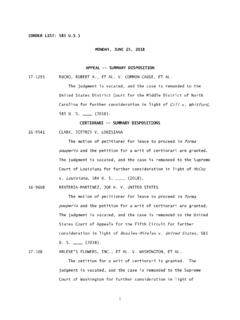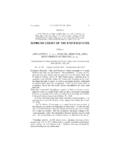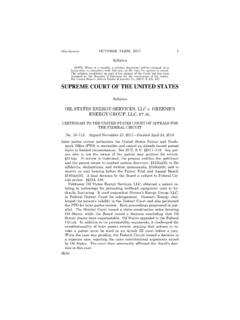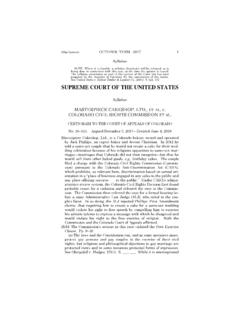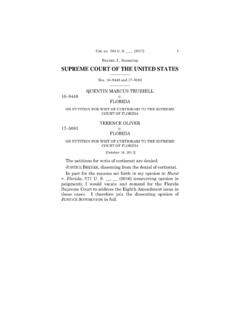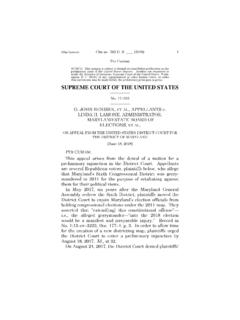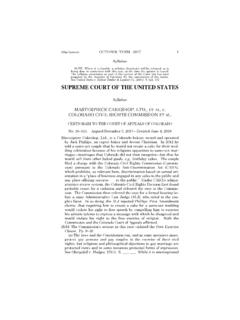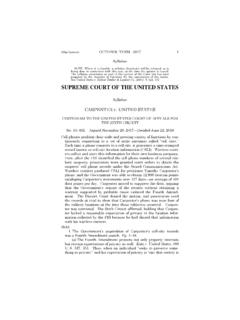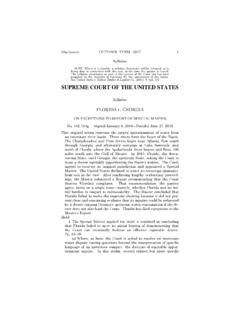Transcription of SUPREME COURT OF THE UNITED STATES
1 1 (Slip Opinion) OCTOBER TERM, 2020 Syllabus NOTE: Where it is feasible, a syllabus (headnote) will be released, as is being done in connection with this case, at the time the opinion is issued. The syllabus constitutes no part of the opinion of the COURT but has been prepared by the Reporter of Decisions for the convenience of the reader. See UNITED STATES v. Detroit Timber & Lumber Co., 200 U. S. 321, 337. SUPREME COURT OF THE UNITED STATES Syllabus CEDAR POINT NURSERY ET AL.
2 V. HASSID ET AL. CERTIORARI TO THE UNITED STATES COURT OF APPEALS FOR THE NINTH CIRCUIT No. 20 107. Argued March 22, 2021 Decided June 23, 2021 A California regulation grants labor organizations a right to take ac-cess to an agricultural employer s property in order to solicit support for unionization. Cal. Code Regs., tit. 8, 20900(e)(1)(C). The regula-tion mandates that agricultural employers allow union organizers ontotheir property for up to three hours per day, 120 days per year. Or-ganizers from the UNITED Farm Workers sought to take access to prop-erty owned by two California growers Cedar Point Nursery andFowler Packing Company.
3 The growers filed suit in Federal DistrictCourt seeking to enjoin enforcement of the access regulation on thegrounds that it appropriated without compensation an easement forunion organizers to enter their property and therefore constituted an unconstitutional per se physical taking under the Fifth and Fourteenth Amendments. The District COURT denied the growers motion for a pre-liminary injunction and dismissed the complaint, holding that the ac-cess regulation did not constitute a per se physical taking because itdid not allow the public to access the growers property in a permanent and continuous manner.
4 A divided panel of the COURT of Appeals for the Ninth Circuit affirmed, and rehearing en banc was denied over dis-sent. Held: California s access regulation constitutes a per se physical taking. Pp. 4 20.(a) The growers complaint STATES a claim for an uncompensated tak-ing in violation of the Fifth and Fourteenth Amendments. Pp. 4 17.(1) The Takings Clause of the Fifth Amendment, applicable to theStates through the Fourteenth Amendment, provides: [N]or shall pri-vate property be taken for public use, without just compensation. When the government physically acquires private property for a public use, the Takings Clause obligates the government to provide the owner 2 CEDAR POINT NURSERY v.
5 HASSID Syllabus with just compensation. Tahoe-Sierra Preservation Council, Inc. v. Ta-hoe Regional Planning Agency, 535 U. S. 302, 321. The COURT assesses such physical takings using a per se rule: The government must pay for what it takes. Id., at 322. A different standard applies when the government, rather than ap-propriating private property for itself or a third party, instead imposes regulations restricting an owner s ability to use his own property. Id., at 321 322. To determine whether such a use restriction amounts to a taking, the COURT has generally applied the flexible approach set forth in Penn Central Transportation Co.
6 V. New York City, 438 U. S. 104, considering factors such as the economic impact of the regulation, its interference with reasonable investment-backed expectations, and the character of the government action. Id., at 124. But when the government physically appropriates property, Penn Central has no place regardless whether the government action takes the form of a regulation, statute, ordinance, or decree. Pp. 4 7.(2) California s access regulation appropriates a right to invade the growers property and therefore constitutes a per se physical tak-ing.
7 Rather than restraining the growers use of their own property, the regulation appropriates for the enjoyment of third parties (here union organizers) the owners right to exclude. The right to exclude is a fundamental element of the property right. Kaiser Aetna v. UNITED STATES , 444 U. S. 164, 179 180. The COURT s precedents have thus treated government-authorized physical invasions as takings requir-ing just compensation. As in previous cases, the government here has appropriated a right of access to private property. Because the regu-lation appropriates a right to physically invade the growers prop-erty to literally take access it constitutes a per se physical taking under the COURT s precedents.
8 Pp. 7 10.(3) The view that the access regulation cannot qualify as a per setaking because it does not allow for permanent and continuous access24 hours a day, 365 days a year is insupportable. The COURT has held that a physical appropriation is a taking whether it is permanent ortemporary; the duration of the appropriation bears only on the amount of compensation due. See UNITED STATES v. Dow, 357 U. S. 17, 26. To be sure, the COURT in Loretto v. Teleprompter Manhattan CATV Corp., 458 U. S. 419, discussed the heightened concerns associated with [t]hepermanence and absolute exclusivity of a physical occupation in con-trast to temporary limitations on the right to exclude, and stated that [n]ot every physical invasion is a taking.
9 Id., at 435, n. 12. But the regulation here is not transformed from a physical taking into a use restriction just because the access granted is restricted to union organ-izers, for a narrow purpose, and for a limited time. And although the 3 Cite as: 594 U. S. ____ (2021) Syllabus Board disputes whether the access regulation appropriates an ease-ment as defined by California law, it cannot absolve itself of takings liability by appropriating the growers right to exclude in a form that is a slight mismatch from state property law.
10 PruneYard Shopping Center v. Robins, 447 U. S. 74, does not cut against the COURT s conclusion that the access regulation constitutes a per se taking. In PruneYard the California SUPREME COURT recognized a right to engage in leafleting at the PruneYard, a privately owned shopping center, and the COURT applied the Penn Central factors to hold that no compensable taking had occurred. 447 U. S., at 78, 83. PruneYard does not establish that limited rights of access to privateproperty should be evaluated as regulatory rather than per se on how a business generally open to the public such as the PruneYard may treat individuals on the premises are readily distin-guishable from regulations granting a right to invade property closed to the public.
